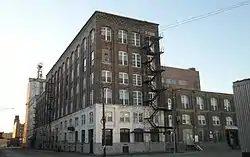Archer Daniels Midland Wheat Mill
The Archer Daniels Midland Wheat Mill was a plant in Chicago's Fulton Market District. The complex included brick loft buildings, a grain elevator, and silos.[1] The oldest buildings in the complex were built in 1897 and were designed by William Carbys Zimmerman and John J. Flanders.[1][2][3][4] It originally served as Eckhart & Swan's wheat and rye mill.[1][2][3][4]
| Archer Daniels Midland Wheat Mill | |
|---|---|
 | |
| General information | |
| Location | 1300 W. Carroll Avenue, Chicago, Illinois |
| Coordinates | 41°53′16.8″N 87°39′35.1″W |
| Completed | 1897–1948 |
| Demolished | 2021 |
| Technical details | |
| Floor area | 250,000 sq ft (23,000 m2) |
| Design and construction | |
| Architect(s) | William Carbys Zimmerman & John J. Flanders |
History
In 1896, Eckhart & Swan purchased the Hess elevators, on Carroll Avenue, between Ada and Elizabeth street, for $75,000.[5][6] In 1897, Eckhart & Swan began constructing a new wheat and rye mill, at a cost of between $250,000 and $300,000, replacing their existing mill at Canal and Fulton.[2][6][3] It was the largest mill in Illinois.[2] In 1909, Eckhart & Swan Milling Company's name was changed to the B. A. Eckhart Milling Company.[7]
An addition was built at the corner of Carroll and Elizabeth in 1910.[8] The grain elevator was built in 1927, and was designed by M. A. Lang.[8][9] In 1927, Eckhart purchased an adjoining property on Elizabeth Street, to build an addition to their plant.[10] The property had been the site of the Puritan Mills feed plant, which burned down the previous year.[10][11] New grain silos were built by Bulley & Andrews in 1948.[8][9]
In 1964, Dixie Portland Flour Mills purchased Eckhart Milling Company.[12] In 1990, Archer Daniels Midland purchased the plant for $14 million.[13] In 2017, Archer Daniels Midland announced that it intended to build a new plant in Mendota, Illinois and close their plant in Chicago.[13][14] In 2018, the plant was sold to Sterling Bay for approximately $25 million.[15][16] Sterling Bay began demolishing the mill on February 11, 2021.[8] Initial reports stated that Sterling Bay planned to build a Metra station on the site.[15][16][1] In February 2021, Preservation Chicago listed the complex as one of Chicago's most endangered buildings.[9][17]
Fires
On March 26, 1912, a suction fan overheated and ignited waste in a wheat cleaning room, starting a fire.[18] The fire was contained to the northern half of the four story building, due to a worker closing a fireproof door.[18] After the firefighters left, a dust explosion caused a partial structural collapse, killing one worker.[18]
On March 18, 1970, an explosion occurred in a storage room on the sixth floor, killing one worker and injuring three, and causing the collapse of the top two floors of the northern edge of the building.[19] Many of the bricks fell onto a freight car parked on tracks to the north of the building.[19] Damage was estimated at $50,000.[19]
References
- "Threatened: Fulton Market Grain Silos and Historic Loft Buildings Sold to Sterling Bay", Preservation Chicago. Retrieved December 23, 2019.
- "Largest in the State; Flour Mill of 2,200 Barrels Capacity to Be Built", Chicago Tribune. August 29, 1897. p. 34.
- "Manufacturing and Building", The Economist. August 7, 1897. p. 152 Retrieved January 28, 2021.
- "Synopsis of Building News", The Inland Architect and News Record. Vol 30, No. 1. August 1897. p. 10. Retrieved January 28, 2021.
- "Big Flour Mill Planned; Eckhart & Swan to Build a Plant on the Pan-Handle Road", Chicago Tribune. July 12, 1896. p. 39.
- "Among the Mills", The Roller Mill. Vol 16, No. 3. September 1897. p. 163. Retrieved December 29, 2019.
- Rowe, Frederick A.; Moses, Joseph W. The National Corporation Reporter. Vol. 39, No. 12. November 4, 1909. p. 365. Retrieved December 25, 2019.
- Ori, Ryan. "Sterling Bay is taking down a late-1800s flour mill in Fulton Market, despite efforts by preservationists", Chicago Tribune. February 12, 2021. Retrieved February 13, 2021.
- "West Loop Industrial Lofts Chicago 7 2021 Archived 2021-03-15 at the Wayback Machine", Preservation Chicago. Retrieved February 26, 2021.
- Chase, Al. "Eckhart Milling Buys Site for Big Warehouse", Chicago Tribune. October 11, 1927. p. 30.
- "Fire Destroys Big West Side Grain Plant", Chicago Tribune. October 13, 1926. p. 1.
- "Dixie Portland Buys Eckhart Flour Mills", Chicago Tribune. July 12, 1964 p. D3.
- Channick, Robert. "ADM to close Fulton Market wheat mill for new LaSalle County plant", Chicago Tribune. June 2, 2017. Retrieved December 26, 2019.
- "What’s That Building? Archer Daniels Midland's Fulton Market Plant", WBEZ. November 8, 2017. Retrieved December 27, 2019.
- Ori, Ryan. "Sterling Bay buying ADM wheat mill in Fulton Market, eyes adding Metra station", Chicago Tribune. August 23, 2018. Retrieved December 27, 2019.
- Kozlarz, Jay. "New Metra station could replace old Fulton Market wheat mill", Curbed. August 24, 2018. Retrieved December 27, 2019.
- Keilman, John. "Chicago lakefront, Catholic churches top newest list of city’s most endangered historic buildings", Chicago Tribune. February 24, 2021. Retrieved February 26, 2021.
- "Recall By Chief Saves 25 Firemen: Dust Explosion Kills Workmen Just After the Fire Fighters Retire – Hero Closes Fire Door – Employee of B. A. Eckhart Mill prevents Spread of Flames; Loss $150,000", Chicago Tribune. March 27, 1912. p. 3.
- Koziol, Ronald. "1 Killed, 3 Injured as Blast Rips a Flour Storage Area", Chicago Tribune. March 19, 1970. Section 1B, p. 3.